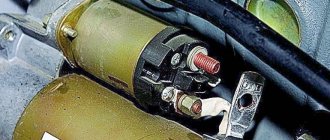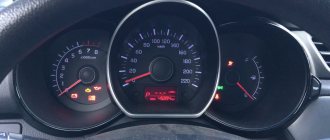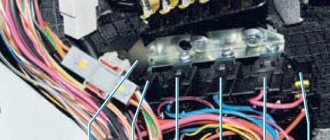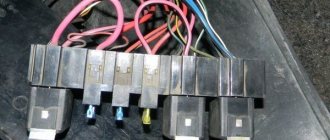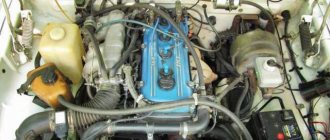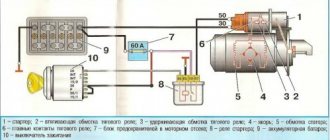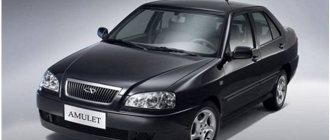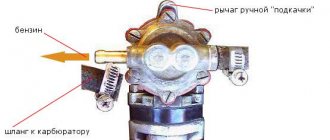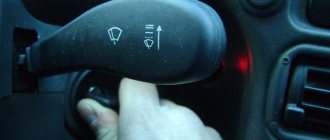It happens that the starter works fine, but the engine stubbornly refuses to start, although the Check lamp does not light up. In such cases, if we talk about the VAZ-2123 engine, we can immediately name 10 different reasons. All of them will be quite real, and not at all from the category of “contacts have oxidized.” In general, sometimes the Chevrolet Niva does not start, but the starter turns the shaft properly, and the reason should not be looked for there. Well, let's try to learn to recognize different reasons, that is, to distinguish one from the other.
Example in the video: the APS immobilizer blocked the engine because it was in learning mode!
Reasons why Chevrolet Niva does not start
- Crankshaft, camshaft position sensor
During vehicle operation, both sensors often fail.
The reasons for this are different: manufacturing defects, natural life, third-party mechanical damage. Since the equipment cannot be repaired due to the design features, the craftsmen install new ones. The replacement process is not long, the cost of consumables is cheap.
- Coolant temperature sensor
By analogy with the crankshaft sensor, the DTOZH cannot be repaired. The installation is quite simple and straightforward. You can do it yourself without involving service station workers.
To a greater extent, the electrical component of the breakdown. The design of the IAC sensor allows for maintenance, cleaning, and blowing with compressed air. Replacement in case of mechanical damage or deformation.
First of all, you need to remove the cap from the spark plug (any one) and install spark plug A17 DVRM. Holding it with pliers, turn on the starter.
To remove the cap, hold the spark plug by the hexagon (pliers with insulated handles are suitable). It is necessary that the spark plug body touches the “ground”. As a result, you will be able to see a spark. In the case where there is no spark, this indicates:
- malfunction of the ECM or lack of voltage;
- combustion of the ignition coil module;
- damage to high-voltage wires.
By the way, a spark “in the air” does not guarantee its presence in the engine. Spark plugs can be faulty, there is a gap violation, etc.
Troubleshooting electrical equipment
Battery
The battery rarely discharges suddenly. Often starting becomes difficult due to low starter speed. But there are also cases when the battery dies in a very short time. When you turn the ignition key, the dashboard may “come to life”, but when you try to turn on the starter, all the lights go out. This is an indicator of battery discharge. As a last resort, you can turn on the headlights and judge the condition of the battery by the brightness of the lamps. The way out is to charge the battery or replace it.
Starter
If the battery is in order, and clicks are heard when you turn the key, then they indicate a fault with the starter. If nothing happens (no reaction), then before sinning on the starter, you need to check the reliability of the connection of the supply wire to the starter solenoid relay. If the starter has become unusable, then its repair is possible, but it depends on the reasons, of which there may be several.
Battery terminals
If the terminals on the battery are loosely tightened, the contact area becomes covered with oxide.
It prevents the passage of current and, over time, completely opens the contact. A cracking noise may be heard when turning the key. The oxidized terminal should be cleaned, lubricated with graphite grease and tightened well.
Candles
The condition of the spark plugs is checked by inspecting the electrodes. If all the spark plugs have black soot and the electrodes are wet, this indicates that none of them are working. A candle has its own resource, but the probability of all of them failing at once is extremely low. The reason must be sought in the ignition module or its power supply. The car may not start if one spark plug is not working. In this case, the spark plug should be replaced .
Circuit breakers
The lack of power to the module is often due to a blown fuse. You need to get a fuse diagram and check the condition of the one that controls the ignition.
Immobilizer
The operation of the immobilizer is quite complex. If its settings are lost, you should try to start the car with a key equipped with a chip. But this rarely happens. The most likely cause is a dead key fob battery.
Spark plugs Niva Chevrolet
Unstable spark plug operation and untimely spark supply contribute to engine detonation. First signs:
- Reduced acceleration dynamics;
- Increased fuel consumption;
- The engine is not running properly;
- Difficulty starting the engine.
Also interesting: Relays and fuses for Lada 4×4 (VAZ 21214, 21314) » Lada.Online
Since spark plugs are a disposable consumable, they cannot be prevented.
The engine does not start in the cold - the first sign of failure of the spark plugs. When in good condition, candles heat the space from the inside. In the event of a breakdown, starting the engine is complicated by low temperatures and the formation of condensation.
We check the spark plugs with a multimeter and replace them with new ones as necessary. We also inspect the spark plug start relay. It should make a slight clicking sound.
The method described above is effective for the injector. In the case of a carburetor, the checking mechanism is as follows:
- open the hood, wait until the engine cools down to a safe temperature;
- remove the cradles one by one, unscrew the spark plugs, check them for a spark;
- install new spark plugs, replace them if defective ones are found;
- assembly in reverse order.
Story
In the 80s of the last century, AvtoVAZ produced a car called “Niva”. The management and engineers of the enterprise began to understand that the model was becoming outdated and losing popularity. Then they started working on updating the Niva. For the first time, the restyled model was presented to a wide audience in 1998 and had the VAZ-2123 index. However, at this time the company was suffering from some economic problems, due to which mass production of the new model could not be carried out in full. At AvtoVAZ itself, the model was produced only from 1998 to 2002, and, as a rule, in small batches. In 2002, it bought the rights to produce the car. From that moment on, the model began a completely different future. The company's specialists began improving the car. The start of production of the Niva-Chevrolet occurred in September 2002. It is worth noting that AvtoVAZ wanted to continue producing the car under the Lada brand, but at . However, the American company compiled the documents in such a way that this became impossible.
A record number of cars produced was recorded between November 2006 and April 2008. Then about 1000 copies rolled off the assembly line. The car was equipped with an Opel Z18XE engine and a 5-speed Aisin manual transmission.
In 2009, the model was restyled. Thanks to this, the appearance of the Niva-Chevrolet has changed significantly. Design elements from BERTONE were installed on it. Changes also affected the chassis and engine.
Voltage blocking alarm
Modern security systems fully control the car, its elements and assemblies. In emergency situations, the alarm will prevent theft, but the alarm may be false.
The reasons for the “false call” are caused by:
- manufacturing defects;
- short circuit in the circuit;
- violations in the operation of the electronic control unit;
- damage to electrical wiring, insulation;
- poor terminal contact.
In order to be able to start the car in the future, you need to deactivate the alarm. However, you need to know what to turn off. To carry out work at a professional level, visit a service station.
Electrical faults
There are quite a lot of components of electrical equipment for a Chevrolet Niva car. Sometimes, in order to find the cause of a breakdown, you have to check all the components one by one. However, the experience of car enthusiasts allows us to identify the most vulnerable elements that cause the malfunction.
- The battery is low. It may fail due to long service life.
- Starter malfunction.
- Lack of contact at the battery terminals.
- Lack of spark (malfunction of spark plugs, power wires, ignition module).
- Fuse blown.
- Ignition switch malfunction.
- Errors in the immobilizer operation.
Operating principle of TPS
There are two types of devices: resistive and non-contact. They differ in design, operating principle and service life.
- Resistive TPS is a variable resistor, the resistance of which changes as the slider moves along the tracks. Due to their simple design and affordable price, they are most common in the automotive industry. The Chevrolet Niva rolls off the assembly line with just such resistive devices.
- Non-contact TPS is based on a circuit that includes a magnetic field sensor and a microcontroller. They last longer and consume less electricity than resistive ones. However, contactless devices are more expensive, and the semiconductor microcontroller can burn out due to sudden voltage surges in the on-board network.
The installation location and operating principle of the TPS does not depend on the design. It is mounted on the throttle shaft. When the throttle position changes, the output voltage at the sensor changes from 0.7 to 4 volts. Due to this, the ECU receives information from the degree of opening of the damper. Based on the information received from the sensor, the composition of the air-fuel mixture is formed. Therefore, the throttle response and efficiency of the engine depend on the performance of the TPS.
When the immobilizer is activated, one way or another, it will block the engine from starting. This happens when, with the ignition on, the indicator starts flashing for 15 seconds and then goes out. Next, the system sends sound signals.
It’s time to disable the module on the Chevrolet Niva APS-4. Here you will need a training key (red), but APS-6 cannot be turned off. Basically, the ECM is forced to flash. There is no need to panic: the blocking is probably due to a broken reader in the cable.
What to do if your car catches fire or another emergency occurs on the road.
Most drivers, when faced with an emergency on the road, may simply panic, which can ultimately lead to a serious accident. Many motorists believe that the more experience they have in driving a car, the more prepared the driver is for dangerous situations that may arise while driving on the highway. But statistics say otherwise. Many experienced drivers, when faced with an emergency situation on the road, begin to panic and ultimately make unforgivable mistakes, which subsequently lead to an accident. Yes, this is true, when a tire in your car unexpectedly breaks and goes flat, or animals suddenly run out onto the road, for example, a dog, elk, wild boar, etc., and the brakes also disappear, these phenomena immediately cause panic in most drivers, which will only increase their risk of getting into a car accident. Therefore, according to experts, every driver, regardless of driving experience, should be well prepared for any of these emergency situations. He must clearly understand what he needs to do or do in certain circumstances.
There are many scary and dangerous things that can happen suddenly, especially when you are driving. But knowing how to react to emergency situations, you may be able to avoid an accident completely, or minimize the consequences of a traffic accident as much as possible. Here's what you need to do in the most common situations that happen on the roads while your car is moving.
Battery Niva Chevrolet
Due to insufficient battery charge, the starter does not rotate, the flywheel does not spin, and the combustible mixture in the combustion chamber does not ignite. To check the battery charge level, you need to use a multimeter.
Lately it has become popular to buy gel batteries. Instead of the usual electrolyte, the compartments are filled with gel. The service life of batteries of this class is 25% longer than analogues.
Also interesting: Replacing a Chevrolet Niva heater radiator with air conditioning without removing the panel
Нет подачи топлива
Нередко двигатель РЅРµ запускается РїСЂРё неисправной РёР »Рё неправвльно отрегулподачи тов їР »РёРІР°. Попытки R·Р°РїСѓСЃРєР° такого дввггателя RѕR±S‹С‡РЅРѕ SЃРѕРїСЂРѕРІРѕР ¶РґР°СЋС‚СЃСЏ S…лопками, выстрелами РІ глушитель, появлением S‡РµСЂРЅРѕРіРѕ RєРѕРїС‚ящего дыРјР° Рё СЃРельного запаха бензина РёР· выхлопной трубы. Неисправность РІ карбюраторном двигателе обычно R ѕРїСЂРµРґРµР»СЏРµС‚СЃСЏ визуально.
RRѕSЃS‚аточно посветить S„онариком РІ перввичную РІРІС‚ оричную камеры. Если РЅР° стенках Ремеются SЃР»РµРґС‹ бензина, Р° РёР· СЂР°СЃРїС‹Р»РёС‚РµР»С Џ ускорительного насосР° топливо РЅРµ распыляется, Р° вытекает тонкой струеР№, — необходимо срочно выявить Рё устранить неисправность. Чтобы точно определить неисправность РІ инжекто SЂРЅРѕРј двигателе – необходимо SЃРїРµС†Реальное оборудованке, подключаемое Рє диагностическому СЂР° зъему автомобиля, СЃРїРѕСЃРѕР±РЅРѕРµ считывать РєРѕРґС‹ РѕС€РеР±РѕРє Рё неисправностей.
Чтобы определить РѕЃРїСЂР°РІРЅРѕСЃС‚СЊ S„РѕСЂСЃСѓРЅРѕРє, следует RѕS‚соеднить РїРѕС‚ рампы, после S‡РµРіРѕ RїРѕРїСЂРѕСЃРёС‚СЊ RїРѕRјR ѕС ‰РЅРёРєР° прокрутить двигатель стартером. Если РїСЂРё этом бензин вытекает РёР· сопла форсунки S‚олс S‚РѕР№ струей, Р»РеР±Рѕ РСРµ вытекает вообще, такую S„РѕСЂСЃСѓРЅРєСѓ SЃР»РµРґСѓРµС‚ РїСЂРѕРјС‹S ‚СЊ РІ ультразвуковой ванне Рели Р· аменить.
Чтобы Резбежать SЂР°Р·Р»РёС‡РЅС‹С… неожиданностей РІ пути, рекомендуется всегда перед выездом проверить РІСЃРµ SЃРёСЃС‚емы дввгателя, устранРёРІ РїСЂРё этом мелкие неисправности. RќР°РїСЂРёРјРµСЂ, ослабление RєРѕРЅС‚акта, наличРеРµ S‚рения RїСЂРѕРІРѕ РґРѕРІ Рё S€Р»Р°РЅРіРѕРІ Рѕ различ ные выступы, потеки масла Рё РґСЂСѓРіРіРёС… жидкостей Рё С‚.Рґ.
R' SЌS‚РѕРј SЃР»СѓС‡Р°Рµ РІС‹ RјРѕР¶РµС‚Рµ РЅРµ S‚олько SѓСЃС‚ранить RјРµР»РєРёР µ поломки, РЅРѕ также РІС‹СЏРІРёС ‚СЊ Рё предупредить более SЃРµСЂСЊРµР·РЅС‹Рµ, которые RјРѕРіСѓS ‚ привестк значительным Р·Р°С‚СЂР°С ‚ам СЃРёР» Рё средств. Оставайтесь всегда РјРѕР±Рельными. RЈРґР°С‡Рё РЅР° РґРѕСЂРѕРіР°С...!
оценок, среднее:
РёР· 5).
Загрузка…
The ability to independently diagnose car faults will allow you to save money on a trip to a car service center, and very significantly. If your Chevrolet Niva does not start, do not rush to call a tow truck or use paid diagnostic services. Perhaps the problem lies on the surface and you can fix it yourself.
Air lock in the fuel line of Niva Chevrolet
There is a control fitting 3 on the ramp with regulator 5. The latter is hidden by a cap; you need to unscrew it and carefully press the spool. Fuel poured out - therefore, it entered the ramp. However, it is possible that the required pressure is not generated. The reasons may be clogged filter cylinder, damage to the pump, etc.
The pressure must show 350 kPa, that is, 3.5 bar. To control it, unscrew the spool and then install a pressure gauge. On the eve of the test, you should reduce your blood pressure. If there is no fuel supply, you need to pay attention to whether the pump turns on or not when turning the key to the “I” mark. When cold, the pump should operate for 10 seconds with the engine running.
The intake of air into the fuel circuit from the outside creates plugs, as a result of which the fuel mixture does not burn in full. A copious amount of carbon deposits is formed, which settles inside the exhaust system and exhaust manifold.
Carbon deposits clog the catalyst, which reduces power, increases fuel consumption, and exposes the engine to unstable idle speed.
You can remove air from the system by connecting a rubber hose to the “return” and grinding off the fuel until the air is removed. Subsequently, the fuel can be reused.
Gas pedal problem
If, while driving, taking your foot off the gas pedal, you notice that the car has not begun to slow down and continues to accelerate, then most likely the floor mat in the car has blocked the gas pedal itself. Under no circumstances try to adjust this mat and unlock the gas pedal while driving. You will only be wasting your time. In this case, there is only one way out, namely, put the gearbox in neutral and then press the brake pedal. This should help you. But if these actions do not help, then turn off the ignition itself. If your car is equipped with a push-button start system (Start/Stop), then to turn off the ignition while the car is moving, you will have to hold down the Start/Stop button for several seconds.
Be sure to remember that when you turn off the ignition of the car while driving, your steering will become very heavy, since at this moment the power steering will turn off and the brakes will become hard and tight, you will need great physical effort to control the car.
Damage to the starting system
The main task of the fuel filter is to timely supply fuel to the combustion chambers. It is difficult to physically check the flow of fuel to the ramp without special equipment.
First, we check the flow of fuel through the filter. The presence (absence) of fuel will be visible through the transparent body. We replace the cleaning element with a new one as needed.
We check the limit switches, terminals on the contacts, injectors, and fuel pump. We clean, remove oxidation, tighten the clamps. We check the fuel pump for serviceability by turning the key in the ignition. A clicking sound is heard from the fuel pump. If there is none, then there is a malfunction in the “pump”.
Failure may manifest itself in improper operation of the starter device. Let us highlight 5 main malfunctions of this mechanism:
- The starter does not turn. The reason lies in a violation of the contact units, a break or short circuit in the starter circuit, or damage to the traction relay.
- When starting the starter on a Chevrolet Niva, there are repeated clicks. This indicates a malfunction of the traction relay, which is held by the winding, a discharge of the battery, or loose contact connections in the starter circuit.
- The starter starts, but the armature either does not rotate or rotates slowly. The cause may be a discharged battery, broken contact connections, burnt contacts of the traction relay, worn brushes, dirty commutator, interturn/short circuit of the windings.
- The starter turns on, the armature rotates, but the flywheel does not move. The problem may be loosening of the starter to the clutch housing, breakage of the flywheel teeth or drive gear. This would also include slipping of the freewheel of the drive and damage to the lever.
- The starter does not turn off after starting the Chevrolet Niva engine. The reason is a malfunction of the freewheel of the starter device, sintering of the contacts of the traction relay. If this damage occurs, stop the engine immediately.
And also interesting: Buy a Chevrolet Niva from an official dealer in St. Petersburg, new Chevrolet Niva 2022, 2022 from 409,300 rubles.
The above reasons require the intervention of specialists at a service station or upon arrival at an equipped garage. You can only check in advance with a voltmeter how discharged the battery is, and also pay attention to the tightness of the contact connections in the starter circuit.
Checking the starter circuit
For starter malfunctions , see the section Diagnosing engine malfunctions: “The crankshaft does not turn with the starter”, “Loud noise when the starter is running”
How to check the functionality of the starter circuit
If the starter does not crank the engine when the ignition key is turned to the appropriate position, then there are four possible reasons:
1. the battery is discharged;
2. the electrical connections between the starting relay, battery and starter are broken, i.e. current from the battery is not supplied to the starter;
3. the starting (traction) relay is faulty;
4. the starter is stuck or its electrical part is faulty.
• To check the battery, turn on the headlights. If they go out after a few seconds, the battery is discharged or damaged. If the headlights are bright, turn on the starter and see what happens to the headlights. If the headlights dim, voltage is supplied to the starter, but it does not rotate. The starter needs to be removed for inspection. If the starter rotates very slowly, proceed to the next test.
• If the headlights still shine brightly when you turn on the starter, then there is no voltage reaching it. Check all connections from the battery to the start relay and starter for tightness and cleanliness. If the car has a good battery, then the most likely cause is a malfunction of the starter itself. Check that the flexible ground wire between the engine and the body is tightly screwed - this sometimes helps eliminate an apparent malfunction.
• If no results are achieved, turn off the headlights to avoid draining the battery. You may hear a clicking sound each time you turn the ignition key to the starter position. These are the sounds of the solenoid (traction relay) operating, but this does not mean that the main contact is operating properly. (If you do not hear a click from the relay, it may be faulty.) The solenoid contact can be checked by connecting a voltmeter or test light to the main wire connection (battery to starter) on the "starter" side of the relay and to ground. When you turn the ignition key, the voltmeter should show voltage, or the light should light up. If this does not happen, then the traction relay is faulty. (Do not connect a light bulb to the two relay contacts. If the starter is working, the light will light up.) If, in the end, it is determined that the relay is working properly, and voltage from the battery is supplied to the starter, then most likely the starter itself is faulty.
Video
Fuel supply filter
There is always a small amount of moisture in the fuel. When this amount is increased, this is what can happen:
- the first start always goes without problems;
- After leaving the car in the parking lot, after 2-3 hours the driver will no longer be able to start the engine without repairs.
Everything mentioned should be attributed to the injection internal combustion engine. And here the fuel filter will be a candidate for failure. So, in the Chevrolet Niva it is located under the bottom in aluminum form. By the way, this is thought out on many machines.
Give way to fools...
There are different people (drivers) on the roads, and they can be divided into several groups:
- Competent drivers - these include people (drivers) with extensive driving experience and experience who read the road situation well, can predict the behavior of other drivers and their behavior is understandable to other road users. These include drivers with little driving experience, who constantly improve their driving skills in their free time from driving and who know how to work on mistakes;
- Beginners are people (drivers) with little driving experience who make a large number of mistakes while driving. They often create a nervous environment around them on the road, which can lead to an emergency.
- Fools are people (drivers) who are not burdened with knowledge of driving behavior and do not want to acquire it. These also include people who are tyrants, who believe that they know everything and they are always right;
- Sick or tired are people (drivers) who are in a state of fatigue or poor health, forced to drive due to certain life circumstances that forced them to drive in such a state;
- Fraudsters are people (drivers) whose main activity is the illegal taking of money or property from the population through fraudulent actions on the roads;
- Bandits are people (drivers) who engage in robbery and murder;
- Psychopaths are people (drivers) in a state of passion or with mental pathologies;
- Reckless drivers are people (drivers) who are capable of meaningless, harmful or offensive actions for the sake of dubious pleasure;
- Sleepy – people (drivers) who fall asleep or are in a sleepy state because... did not spend enough time on your sleep;
- Drunks are people (drivers) who are driving under the influence of drugs or alcohol.
For comfortable and safe road traffic, it is necessary to realize and understand that all of the listed groups of drivers are on the road in one proportion or another. You need to come to terms with this, calm down and treat it with understanding. You should not waste your nerves and health on the not entirely adequate behavior of this or that driver. There are not enough nerves and health for everyone.
It is not necessary to accurately determine who is driving a particular car.
Don't bother yourself with this, as human attention is limited. You can't keep track of everything
If a car appears near you, the driver of which behaves strangely (performs dangerous maneuvers or provocative actions), stay away from it. If this is not possible, then take all possible measures to avoid problems associated with such a driver:
- increase the distance;
- pull over to the side of the road;
- change your braking style;
- contact law enforcement agencies;
- move to busy places;
- turn on the emergency lights.
There is no need to teach fools how to live. They could be scammers or bandits. Remember that scammers or bandits can disguise their behavior as that of newcomers!
There is no need to teach newbies life. Due to their inexperience, they can cause such an accident, after which you will have to sort out problems for a long time.
Sometimes drivers may do strange or inexplicable things due to limited visibility.
You need to be more lenient towards people (drivers) on the road, since you were also a newbie and sometimes you also make mistakes!
Tips for care and maintenance of Niva Chevrolet
- Observe technical inspection intervals every 20,000 km;
- Buy original parts with factory catalog numbers. Avoid buying cheap analogues of dubious origin;
- During the warranty period from the manufacturer, visit a service station to undergo routine diagnostics with a note in the service book;
- Remember that the length of its service life depends on the driving style of the car;
- Observe the timing of the transition to the summer/winter tire seasons, check the tire pressure.
Mechanical faults
Reasons caused by the mechanical part of the car include: clogging of the fuel filter or fuel pump, which causes both elements to fail; clogged injectors; running out of oil in the engine or coolant in the radiator. The last reason is very dangerous, as this can cause the power unit to overheat and fail. It’s rare, but it still happens that the engine does not start due to running out of gasoline, because the driver did not keep track of its level, or because of a broken fuel sensor.
How to troubleshoot problems on a Niva Chevrolet
| Sign | Elimination |
| The starter rotates but the flywheel does not move. | Wear of flywheel teeth cannot be prevented. Installing a new |
| The starter rotates very slowly and engages intermittently | Low battery voltage. Recharging, replacement. |
| The starter does not turn over in cold weather | The battery is severely discharged and has become unusable. Installing a new |
| The engine starts the second and subsequent times when cold. | Unstable supply of current, spark, fuel. It is necessary to comprehensively check the fuel system, as there can be many reasons |
| The engine takes a long time to start when hot and then immediately stalls. | Clean the throttle valve, check the fuel filter, fuel pump |
| The immobilizer lamp lights up on the dashboard, indicating a breakdown in the power system. | Check the tension of the drive belt, the reliability of the generator, contacts, terminals |
| When starting the engine, a metallic grinding or creaking noise is heard. | Most likely the shaft bearing is worn out, the spring is deformed, the flywheel teeth are damaged |
Regardless of the type of breakdown or the availability of technical equipment maintenance skills, use the services of a service station, where they provide a quality guarantee for the work performed.
Independent intervention in repairs does not always bring positive results. Use the services of handicraft workshops less often.
Read news about the new Niva
- Chevrolet Niva won't start; the starter doesn't turn: it just clicks.
- How to connect a speed sensor in a field
- Phase sensor Niva Chevrolet symptoms of malfunction, DPRV high signal level
- Chevrolet Niva camshaft sensor
- Fuses for Niva 21214: where are they located, replacement
- Relays and fuses Lada 4×4 (VAZ 21214, 21314) » Lada.Online || Niva sensor under the hood
- Niva Chevrolet knock sensor: where is it located, replacement
- Chevrolet Niva idle speed sensor
Video diagnosing the causes of an uncertain cold start
who had such a VAZ 21214 in the cold, heated it up with a heater, it wouldn’t start, it was running for a long time, there were no sparks when it cooled down with half a turn, I still haven’t found the reason
Thanks for the good article! Everything is very competent and clear. Nothing extra. This information helped me!
Sh Niva. Launched. The engine ran and died. The check light is on. I turn off the ignition, the “check” continues to burn (it burns for a long time and does not go out and... does not go out). The engine does NOT start at all. The starter turns perfectly (the battery is good). B/c “State” has switched off and doesn’t want to show anything (or rather, it hasn’t completely switched off, it’s highlighting something – it seems like it’s downtime). Now... the main focus: I connect the adapter to the OBD-2 chip. — the check went out. I turn on the ignition, now all the indicators light up as expected and the instruments work. Turn to “start” - the “check” goes out, the engine starts, it works as expected. B/C also started working normally, I checked for errors - there are none. The diagnostics sees the adapter turned on, then shows nothing, and... writes that “there is no connection with the ECM.” But the engine runs smoothly and the “check” does NOT light up. Again the trick: I pull the adapter off the diagnostic fastener, the check light comes on, the engine stalls. I turn off the ignition... the “check” continues to light and does not go out even after 5, 10, 20 minutes - but the ignition is OFF,
Guys, please tell me Justa Sh Niva sat for two days, started up and stalled, the pump is running in the frame, the fuel is under pressure, I blame the battery. When checking there is no spark, when the starter is turned off there is one spark and that’s it. Haven't looked at the density yet
The spark does not depend on the battery. You need to look for errors, then the presence of a spark at all nodes
Chevy Niva 2003. I drove home from work. Turned it off. After five minutes, launch - 0 emotions. The starter turns, there is a spark, the engine tries to catch, the fuel pump works, but the engine does not start. I tried changing the crankshaft sensor. Did not help. I tried many of the methods given here, none of them helped. Where to dig - idk...
What have you tried? Compression, that is, maybe the kirdyk has arrived. Fuel pressure?
The pressure in the fuel rail is 1. The alarm that goes off is 2, maybe there is a relay there. Compression - 3.
Good evening. Such a problem, a 2009 Chevy, the car starts, you can drive, or it idles, then it stalls, there is no power to the pump and there is no spark, if it sits for half an hour, it works again, but not for long, and so on in a circle. I can't imagine what's going on
Source
